“Je me souviens” — à la Elisabeth #1 – #7
I am starting something about which I have been thinking for quite a while, a little mimicry of “Je me souviens” (“I remember”) by Georges Perec.
Every day I will prepare a “Je me souviens” post – both in French and in English and present them here for you frequently… please feel free to add your own memories in the comments below.
In terms of how MyFrenchLife members may benefit by this new series, it may help you understand cultural events and societal issues in France in the recent past (my lifetime) as I grew up in the north of France. These posts can also be used to help with your French language practice. Amusez-vous.
Context
For those who are not familiar with George Parec and his book/s this might help provide context:

“Impossible book to put down. In fact, I’m going to read it again. Kind of based on Joe Brainard’s famous and great “I Remember’ but different in that Perec didn’t read that book, but he heard about it from his friend the writer Harry Mathews. While Brainard’s book is more personal and deals with his own observations, Perec’s take on “I Remember” is more of the collective memory of the French from a certain time, mostly from the post-war years. So what he remembers here are a lot of French figures from the cinema, music and pop cultural world of Paris 1950s to the 60s – and I think beyond. My favorite, of course, is “I remember that Boris Vian died while coming out of a showing of a film adapted from his book ‘I Spit on Your Graves'”
by ‘Tosh’ from Goodreads, where you can read more….
Navigation
How to Navigate these “Je me souviens” articles? Each of these articles is updated daily and published weekly, so that you get 7 posts all at once – total immersion: French culture and French language immersion all in one.— If you haven’t seen this article before, then start at the very bottom of this page.
— The most recent posts are found immediately below this comment.
Je me souviens #7: scopitones – video jukeboxes
Je me souviens des Scopitones, ces jukeboxes qui jouaient des clips vidéo (qui portaient aussi le nom de “scopitones”) et qu’on trouvait dans certains cafés français dans les années soixante. Il suffisait de mettre un pièce d’un franc dans l’appareil, et il jouait le clip que vous aviez sélectionné. Le Scopitone qui, d’aprés mes recherches sur l’internet, fut créé en France par la société Cameca, précédait MTV d’une vingtaine d’années.
Andrée Davis-Boyer (1918-2012), une impresario de vedettes françaises de la chanson, devint la productice la plus acharnée et la plus prolifique de vidéos pour scopitones, ce qui lui valut le surnom de “Mamy Scopitone.” Le célèbre cinéaste Claude Lelouch (né en 1937) réalisera une centaine de scopitones de vedettes “yé-yé” telles que Johnny Hallyday, Sylvie Vartan, Jeanne Moreau, Claude Nougaro, Dalida, Claude François, et Les Chats Sauvages.
Ces clips étaient faits à la va-vite et avec un budget souvent dérisoire. Ils sont tout bonnement figés dans une époque révolue dont ils incarnent le charme et la naÏveté.
Ah, nostalgie, quand tu nous tiens….
Translation:
I remember Scopitones, those jukeboxes that played video clips (also called “scopitones”), and that you could find in some French cafés during the 1960s. All you had to do was put a French franc coin into the machine, and it would play the clip that you had selected. The Scopitone which, according to what I found online, was created in France by the Cameca company – came about some twenty years before MTV.
The Cinémathéque Française mentions that Andrée Davis-Boyer (1918-2012), the agent of many famous French singers, became the staunchest and most prolific producer of scopitone videos, which earned her the nickname of “Mamy Scopitone.” The famous French movie director Claude Lelouch (born in 1937) will direct about 100 scopitones featuring “yé-yé” era stars such as Johnny Hallyday, Sylvie Vartan, Jeanne Moreau, Claude Nougaro, Dalida, Claude François, and Les Chats Sauvages.
Those clips were made quickly and on a very small budget. They seem to be frozen in a long-gone era whose charm and naÏveté they fully embody.
Oh, nostalgia, when you get a hold of us….
Clip Scopitone: “Tous les garçons et les filles” by Françoise Hardy, directed by Claude Lelouch (above)
Here also is a brief interview of Françoise Hardy, in which she discusses the conditions under which the above video was shot.
Je me souviens #6: fêtes de la Toussaint
Je me souviens des fêtes de la Toussaint de ma petite enfance. Mon père, tout comme son père et son grand-père paternal avait une entreprise de marbrerie dans ma ville natale de Marcq-en-Baroeul, dans la banlieue de Lille, jusqu’en 1960 environ où pour des raisons de santé, il avait dû abandoner cette activité professionnelle (j’avais alors 6 ans). La plus grande partie de son artisanat était la fabrication de pierre tombales qu’il gravait aussi. Il passait donc pas mal de temps au cimetière du Bourg de Marcq (où, du reste, mes parents et d’autres membres de ma famille sont enterrés.)
Mes parents avaient fait construire un petit magasin de fleurs juste à côté du cimetière, et c’était ma mère qui tenait ce commerce. Un peu avant la Toussaint, mes parents installaient une immense tente sur le terrain adjacent à “Fleurs de France,” dans laquelle s’entassaient des centaines de pots de chrysanthèmes (sur ce terrain devait être construite un peu plus tard ce qui devait devenir la maison de leurs bons amis et anciens voisins, Thérèse et Michel Leroy.)
En effet, le premier novembre, qui est un jour férié en France, les gens vont sur la tombe des membres de leur famille qui sont décédés et y déposent des chrysanthèmes. Ma mère avait une peur maladive que ses chrysanthèmes ne se vendent pas et que, comme elle le disait, elle finisse par “boire un bouillon de chrysanthèmes.” Je pense que cela ne s’est jamais produit.
Translation:
I remember the feast of All Saints’ Day when I was a little girl. My father, as did his father and paternal grandfather, owned a marble masonry workshop in my native town of Marcq-en-Baroeul, a suburb of Lille, until about 1960, when he had to give up this line of work due to health issues (I was six years old then.) Most of his craft was devoted to making tombstones, which he would also carve. Therefore, he spent quite a bit of time in the Bourg Cemetery in Marcq (where, by the way, my parents and other family members are buried.)
My parents had a small flower shop built next to the cemetery, and my mother ran this business. A bit before All Saints’ Day, my parents would set up a huge tent on the piece of land adjacent to “Fleurs de France,” in which they stored hundreds of potted chrysanthemums (on that land stood, later on, a house built by their good friends and ex-neighbors, Thérèse and Michel Leroy.)
Indeed, on November 1st, which is a national holiday in France, people visit the tombs of their deceased family members, on which they deposit chrysanthemums. My mother was deadly scared that her chrysanthemums would not sell and, as she put it, that she would end up having “to drink a whole bunch of chrysanthemum broth.” I do not think that this ever happened.
Photos:
1. Ma mère devant son magasin de fleurs.
2. Mon grand-père paternel avec un jeune homme non-identifié, dans son atelier de marbrerie (je crois) – probablement après qu’il avait pris sa retraite et avait cédé cette affaire à mon père.
1. My mother, in front of her flower shop.
2. My paternal grandfather, and an unidentified young man, in his marble masonry workshop (I think) – most likely after he had retired and my father had taken over that business.
Je me souviens #5: La Madeleine
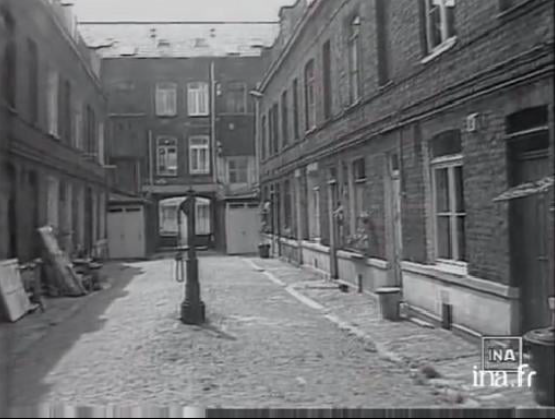
Je me souviens que, quand nous habitions La Madeleine entre 1962 et 1968, nous avions une femme de ménage joviale et rondelette que nous avions surnommée “Ma” parce que, quand quelque chose la surprenait, elle s’exclamait “Ma!!!” (probablement une abréviation de “Maman!”). Ma et son mari habitaient une courée.
Les courées, assez communes dans Lille et sa banlieue jusqu’à la fin des années soixante, étaient des ensembles de logement d’ouvriers formés de petites maisons basses regroupées autour d’une cour.
Ces maisons très modestes n’avaient pas l’eau courante et les habitants des courées n’avaient qu’un point d’eau et des cabinets communs qui se trouvaient au fond de la cour. Inutile de dire que ce type de logement était insalubre. Mais la maison de Ma était d’une propreté absolument exemplaire et son intérieur charmant. Mon père avait aidé Ma et son mari à obtenir un appartement en HLM équipé du chauffage central et d’installations sanitaires modernes et ceux-ci lui en étaient restés des plus reconnaissants. Un fait amusant est que pour Ma, dont le niveau d’éducation n’avait pas dû dépasser l’école primaire, l’évier de la cuisine était toujours “le lévier.”
Translation:
I remember that, when we lived in La Madeleine between 1962 and 1968, we had a jovial and rotund cleaning lady whom we had nicknamed “Ma” because, when she was surprised, she would exclaim “Ma!!!” (probably an abbreviation of “Maman!”). Ma and her husband lived in a “courée.”
“Courées,” which were rather common in Lille and its suburbs until the end of the 60s, was a form of workers’ housing consisting of small houses built around a courtyard.
Those very humble houses had no running water and their dwellers shared one common source of water and a few outhouses located at the back of the courtyard. It goes without saying that this kind of housing was unsanitary. Yet, Ma’s house was spick and span and its interior quite charming. My father helped Ma and her husband get an apartment equipped with central heating and modern plumbing in a housing project, and they were extremely grateful to him. An amusing fact is that for Ma, whose education had most likely ended after elementary school, the kitchen sink was always “le lévier,” when it is actually “l’évier.”
Photo: Une courée typique du nord de la France. A typical “courée” in northern France.
Je me souviens #4: la Foire Commerciale de Lille
Je me souviens de la Foire Commerciale de Lille, un immense paradis du consommateur qui ouvrait ses portes à tous chaque année, pendant une semaine du mois d’avril. Dans centaines de stands, des exposants français et étrangers y présentaient leurs nouveautés dans le Grand Palais de la Foire Internationale de Lille. Tous les domaines y étaient représentés: l’automobile, l’électro-ménager, l’électronique, le mobilier, la gastronomie, le tourisme, et plus encore….
Il y avait aussi un tas d’animations diverses et, comme beaucoup d’autres, ma famille y passait une journée. Je n’en ai qu’un souvenir très vague, mais quand j’avais cinq ou six ans, je me suis perdue dans la foire. Mes parents m’ont raconté que quand ils étaient arrivés, paniqués, aux services de sécurité où la personne qui m’avait trouvée avait dû m’amener, j’étais tout à fait calme et en pleine conversation avec un agent de police ou un gardien chargé de la sécurité.
* Note: Le Général de Gaulle, alors Président de la République, avait inauguré la Foire de Lille en 1966. J’ai encore le menu du banquet de cette inauguration, qu’un ami de mon père lui avait donné (photos jointes.)
Translation:
I remember the Foire Commerciale de Lille, a huge consumer paradise that opened its doors to all each year, for one week in April. In hundreds of booths, exhibitors from France and foreign countries displayed their newest wares in the Great Exhibit Hall in Lille – le Grand Palais de la Foire Internationale. Every trade area was represented: cars, home appliances, electronics, furniture, food, tourism, and more….
There were also all sorts of activities and, like many others, my family would spend a day there. I only have a very vague memory of this but, when I was five or six years old, I got lost at the fair. My parents told me that when they arrived, panicked, at the security office where the person who had found me must have brought me, I was totally relaxed, and in deep conversation with a cop or a security guard.
* Note: General de Gaulle, then the French President, had inaugurated the Foire de Lille in 1966. I still have the menu from that inaugural banquet, which one of my father’s friends had given him (photos above.)
Je me souviens #3: j’adorais la ducasse
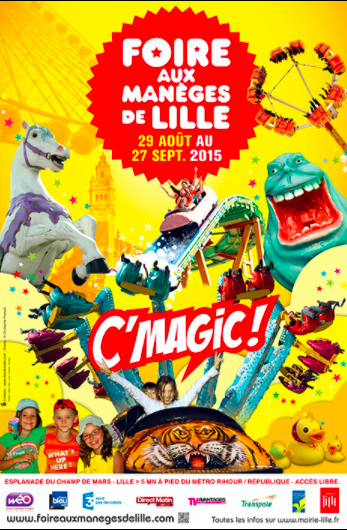
Je me souviens que j’adorais la ducasse – le nom que l’on donne dans le nord de la France aux fêtes foraines – quand j’étais petite.
Mes parents nous emmenaient, mon frère et moi, à la grande ducasse qui se tenait au mois de septembre sur l’immense Esplanade de Lille. Je faisais des tas de tours de manège et j’attrapais très souvent le pompon, ce qui me valait un tour de manège gratuit. Mes parents étaient persuadés que le forain qui tenait le manège me le mettait exprès pratiquement dans la main parce que j’étais très petite et mignonne.
Pendant un certain temps, cette prouesse m’avait valu le surnom de “pompon” que me donnait mon père.
Translation:
I remember that I adored the “ducasse” – the word used in northern France to designate a carnival – when I was little.
My parents would take my brother and me to the big fair that was held every September on the huge Esplanade in Lille. I would go on endless carousel rides, and I would grab the pompom (in the U.S., it is actually a ring) very often, which got me a free ride on the carousel. My parents were convinced that the carny who ran the carousel lowered it purposefully close to my hand because I was very small and cute.
For some time, this feat earned me the nickname of “Pompon,” given to me by my father.
Je me souviens #2: pistolets
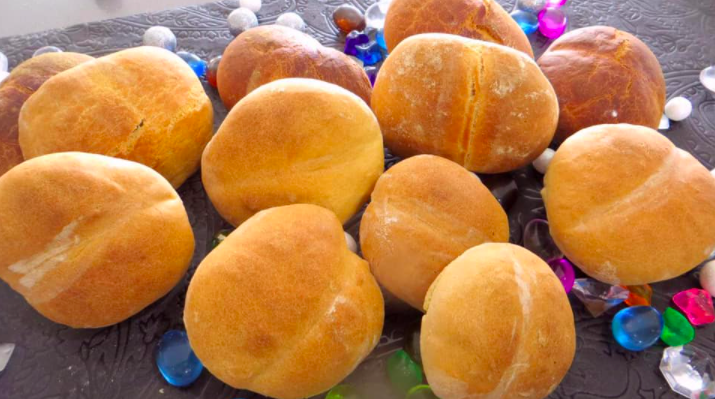
Je me souviens que, pendant quelques années vers la deuxième moitié des années soixante, quand ma famille habitait La Madeleine, dans la banlieue de Lille (France), on achetait des petits pains du nom de “pistolets” chez le boulanger-pâtissier d’à côté pour notre petit déjeuner du dimanche matin. Ils étaient tout frais, quelquefois encore chauds, et bien beurrés, absolument délicieux! Plus tard, le dimanche, c’était de la baguette, que ma mère aimait “bien cuite” et très brune et que moi, je préférais très blonde.
Translation:
I remember that, for a few years around the second half of the sixties, when my family lived in La Madeleine, a suburb of Lille (France), we would buy bread rolls called “pistolets” at the near bakery for our Sunday breakfast. They were very fresh, sometimes still warm, and, nicely buttered, absolutely delicious! Later on, on Sundays, we had baguette, which my mother liked “well done” and rather dark, and that I preferred very light.
Je me souviens #1: vaccin
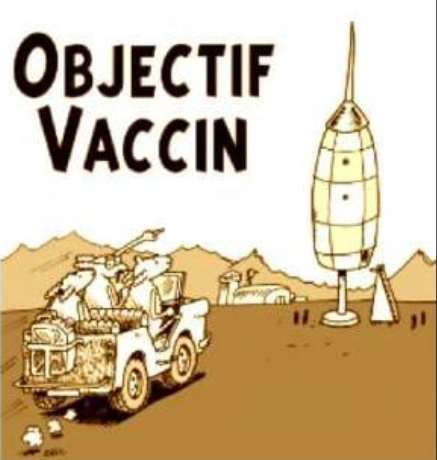
My first ‘souviens‘ will have to do with booster shots since, my husband, and I both got our Moderna booster shots today.
“Je me souviens que mon frère et moi sommes allés une fois seuls à l’Institut Pasteur de Lille pour y recevoir notre piqûre de rappel du vaccin contre la polio. Nous devions alors avoir 13 ou 14 ans.”
Translation:
I remember that my brother and I went once alone to the Pasteur Institute in Lille to get our polio vaccine booster shot. We must have been 13 or 14 years old at the time.
Do these memories pique your interest or anything in your memory? Or if you have questions please ask Elisabeth in the comments below.
If you are a French language student – please join Judy MacMahon as she uses Elisabeth’s memories as a study exercise. Which vocab or grammatical points or expressions are unfamiliar to you? Please share in the comments below.
This series began here “Je me souviens” #1-#7
And here you’ll find “Je me souviens” #8-#14
To discover “Je me souviens” #15-#18, you’ll discover it here



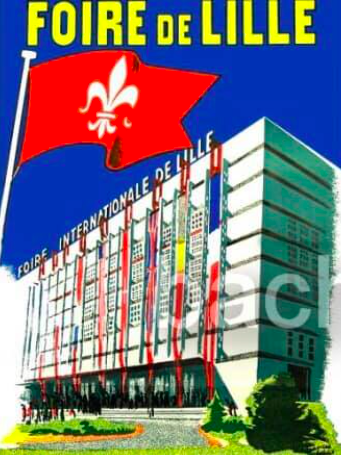

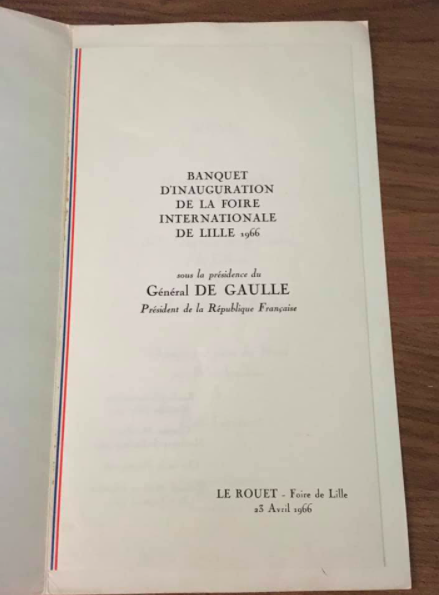







A note for other language students. Here are some highlights for me <3 I would love it if others joined in... 🙂 I realise that this exercise exposed the weaknesses in my French, but acknowledging a weakness surely is the first step to improving it 😉
Oh Elisabeth I love these... Already I'm finding a) cultural/societal points of interest and b) French language highlights...
EG:
**#7 Je me souviens #7: scopitones – video jukeboxes**
1. - des Scopitones, ces jukeboxes qui jouaient des clips vidéo
- Le Scopitone qui, d’aprés mes recherches sur l’internet, fut créé en France par la société Cameca, précédait MTV d’une vingtaine d’années.
- I've never heard this word in French or English - donc, merci !
2. la Vendette - a star. Et... une centaine de scopitones de vedettes “yé-yé” !
3. la plus acharnée - the more determined/fierce/staunch
4. Ces clips étaient faits à la va-vite -- va-vite - in a rush 🙂
5. figé - frozen, rigid, fixed, set
6. tout bonnement - just
7. ...and I forgot this one - yé-yé - The term "yé-yé" was derived from the English term "yeah! yeah!" popularised by the Beatles, Françoise Hardy etc : https://en.wikipedia.org/wiki/Y%C3%A9-y%C3%A9
——-
**Je me souviens #6: fêtes de la Toussaint**
1. s’entasser – to pile up/ cram
2. Ma mère avait une peur maladive que — maladive – unhealthy, sickly
——-
**Je me souviens #5: La Madeleine**
1. HLM – https://en.wikipedia.org/wiki/HLM – public housing
2. l’évier (m)- sink
——-
**Je me souviens #4: la Foire Commerciale de Lille**
1. un tas d’animations diverses — un tas de – loads of
——-
**Je me souviens #3: j’adorais la ducasse**
1. la ducasse – the fair, fete, festival, carnival
2. Je faisais des tas de tours de manège — tours de manège – rides (merry-go-round/carousel, twister etc) rides,
3. le forain – the stallholder
——-
**Je me souviens #2: pistolets**
1. pistolets – little bread rolls
——
**Je me souviens #1: vaccin**
rien à trouver – court et simple
Merci Elisabeth j’ai hâte de lire le prochain épisode.